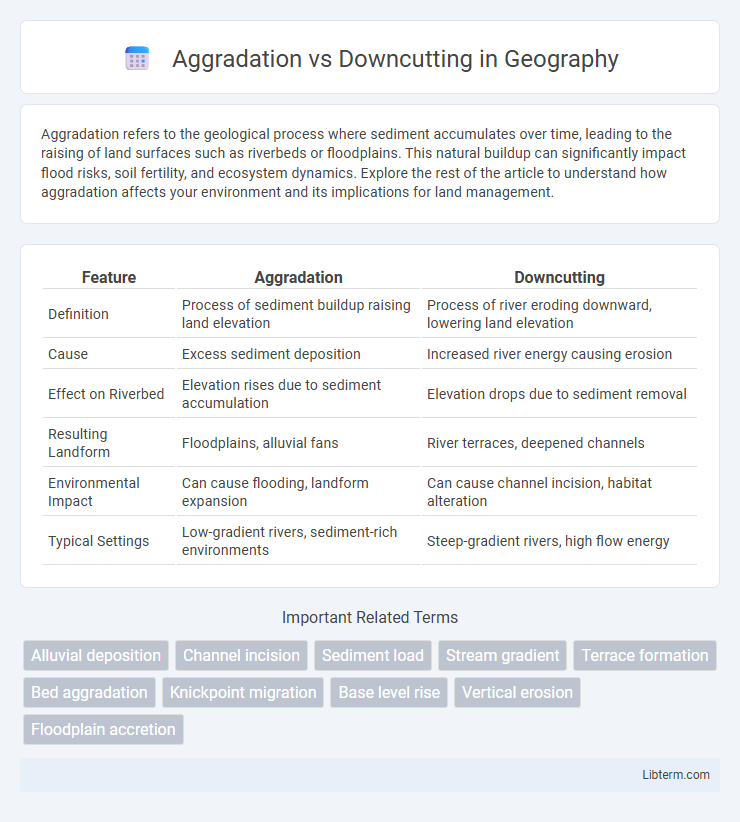Aggradation refers to the geological process where sediment accumulates over time, leading to the raising of land surfaces such as riverbeds or floodplains. This natural buildup can significantly impact flood risks, soil fertility, and ecosystem dynamics. Explore the rest of the article to understand how aggradation affects your environment and its implications for land management.
Table of Comparison
| Feature | Aggradation | Downcutting |
|---|---|---|
| Definition | Process of sediment buildup raising land elevation | Process of river eroding downward, lowering land elevation |
| Cause | Excess sediment deposition | Increased river energy causing erosion |
| Effect on Riverbed | Elevation rises due to sediment accumulation | Elevation drops due to sediment removal |
| Resulting Landform | Floodplains, alluvial fans | River terraces, deepened channels |
| Environmental Impact | Can cause flooding, landform expansion | Can cause channel incision, habitat alteration |
| Typical Settings | Low-gradient rivers, sediment-rich environments | Steep-gradient rivers, high flow energy |
Introduction to Aggradation and Downcutting
Aggradation refers to the progressive accumulation of sediment in a riverbed or valley, resulting in a rise in land elevation over time. Downcutting involves the erosion and deepening of a river channel by removing sediment, lowering the bed level. These contrasting geomorphic processes shape landscapes by either building up or eroding landforms depending on sediment supply and flow dynamics.
Defining Aggradation: Processes and Causes
Aggradation refers to the geological process where sediment accumulates, raising the land surface or riverbed through deposition of materials such as sand, silt, and clay. This process occurs primarily in river valleys, floodplains, and coastal environments due to a decrease in water velocity or an increase in sediment supply, causing particles to settle. Key causes of aggradation include upstream erosion, changes in climate leading to increased sediment load, and human activities like deforestation and construction that accelerate sediment deposition.
Understanding Downcutting: Mechanisms and Effects
Downcutting refers to the process where a river or stream erodes its bed vertically, deepening the channel primarily through hydraulic action and abrasion. This geomorphological mechanism occurs when the flow's energy exceeds sediment deposition, often triggered by a drop in base level or increased water discharge. The effects of downcutting include the formation of incised valleys, steeper channel gradients, and potential destabilization of adjacent landforms, influencing landscape evolution and sediment transport dynamics.
Key Differences Between Aggradation and Downcutting
Aggradation refers to the process of sediment accumulation leading to the raising of a riverbed or land surface, while downcutting involves the erosion and deepening of a river channel. Key differences include that aggradation increases land elevation through deposition of materials like sand and gravel, whereas downcutting lowers the landscape by removing soil and rock. Aggradation typically occurs in environments with high sediment supply and reduced water velocity, contrasting with downcutting which happens in areas with faster water flow and limited sediment availability.
Environmental Factors Affecting Both Processes
Aggradation and downcutting are influenced by environmental factors such as sediment supply, water flow velocity, and vegetation cover. High sediment supply combined with slower water velocity promotes aggradation by depositing materials, while increased flow velocity and reduced sediment load accelerate downcutting by eroding the riverbed. Vegetation stabilizes soil and reduces erosion, favoring aggradation, whereas deforestation or soil disturbance disrupts sediment balance and enhances downcutting.
Impacts on River Morphology and Landscape
Aggradation increases riverbed elevation by depositing sediments, leading to wider, shallower channels and potentially forming floodplains and terraces that reshape the landscape. Downcutting erodes the riverbed, deepening channels and steepening valley slopes, which can create incised valleys and reduce floodplain extent. These processes drive dynamic changes in river morphology, influencing habitat diversity, sediment transport, and flood risk in the surrounding environment.
Human Influences on Aggradation and Downcutting
Human activities such as dam construction, river channelization, and deforestation significantly impact aggradation and downcutting processes by altering sediment supply and flow dynamics. Increased sediment runoff from urbanization and agriculture accelerates aggradation, leading to elevated riverbeds and increased flood risks. Conversely, dams trap sediment and reduce downstream supply, promoting downcutting and streambed incision that can destabilize riverbanks and infrastructure.
Examples from Real-World River Systems
The Mississippi River exhibits aggradation through sediment deposition in its delta, raising the riverbed and forming extensive floodplains. The Colorado River showcases downcutting, carving deep canyons such as the Grand Canyon by eroding bedrock and lowering its channel. These contrasting processes illustrate how sediment load and river gradient influence landscape evolution in diverse fluvial environments.
Geomorphological Significance in Watershed Management
Aggradation and downcutting are critical geomorphological processes influencing sediment dynamics and channel morphology in watershed management. Aggradation involves sediment deposition raising the riverbed, promoting floodplain development and enhancing groundwater recharge, while downcutting entails riverbed erosion lowering the channel, increasing sediment transport downstream and potentially destabilizing banks. Effective watershed management requires balancing these processes to maintain channel stability, prevent excessive sedimentation, and sustain aquatic habitats.
Conclusion: Balancing Aggradation and Downcutting in River Systems
Maintaining equilibrium between aggradation and downcutting is crucial for the stability and health of river systems, as excessive aggradation can lead to flooding and habitat disruption, while dominant downcutting may cause channel incision and bank erosion. Effective river management requires continuous monitoring of sediment supply, flow regimes, and morphological changes to prevent destabilization. Achieving a dynamic balance supports biodiversity, water quality, and sustainable riverine ecosystems.
Aggradation Infographic

 libterm.com
libterm.com